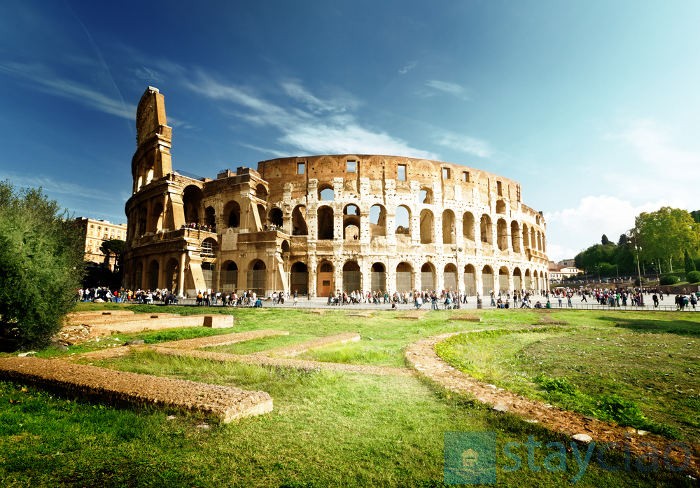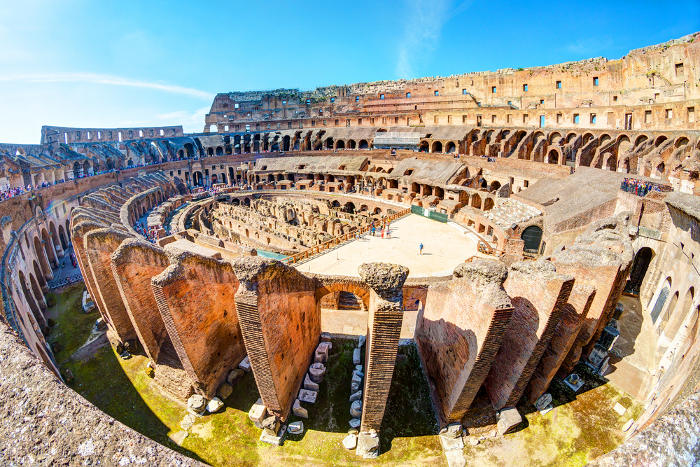
When we talk about holidays in Italy, usually we mean in Rome. And when someone comes to Rome, what’s the first thing they think of? The Roman Colosseum, the symbol of the Eternal City and of the whole of Italy. For this reason this blog is starting its journey to explore Italy right with the Colosseum and its history dating back thousands of years. It’s not only important for its size and magnificence but also and above all for what it represented in Ancient Rome: games and acts of violence against men and animals from all over the Roman Empire.
History of the Colosseum

The Colosseum was built by Emperor Vespasian on part of the site of Nero’s Domus Aurea (Golden House). Vespasian lived to see the completion of the first two floors. It was inaugurated in 80 AC by Tito, Vespasian’s successor, who added the third and fourth tiers of seating. On its inauguration Tito staged games which lasted all of 100 days during which over 5,000 animals were killed! Then Tito’s successor, Emperor Domitian made further modifications, completing the whole building with the addition of all the structures underneath the arena itself. After the completion of the works it was no longer possible to stage naumachia (reenactments of naval battles) in the arena, which had been a feature of the preceding era. During the Imperial age, the Colosseum played host to the largest and most cruel spectacles of the whole of Rome’s history. In 217 there was a fire which caused parts of the upper storeys to collapse and led to the closure of the amphitheatre for five years. With the end of the Empire, the Colosseum fell into decline: it was abandoned, reassigned as a burial ground, damaged by earthquakes, and was used as a source of building materials – where large blocks of the tavertine marble were removed. It then became redesignated as a Christian place of worship and people even lived there. In recent times it has been reclaimed and subject to repeated and extensive restoration, made necessary by its very poor state of repair following centuries of neglect.
What does the Colosseum represent today?
The Colosseum was the largest Amphitheatre in the world with a capacity of 50,000 to 80,000 spectators. It was the stage for Rome’s Games. This list shows the extent of what went on there: animal fights (venations); killings of prisoners condemned to death by wild animals; other kinds of executions and fights between gladiators. Such activities had a set programme: morning was for animal fights or fights between gladiators and animals; lunchtime was when people were put to death; and the afternoon was for the gladiator fights. Imagine, tens of thousands of animals and gladiators died in the Colosseum! Gladiator fights took place right up to 400 after which only animal fights took place in the Colosseum.
What does the name Colosseum actually mean?
First of all I need to say that its original name was not Colosseum but rather Amphitheatre Flavio, having been constructed during the Flavian dynasty. It acquired the name Colosseum during the Middle Ages because of its close proximity to the Colossus of Nero, the enormous statue of Emperor Nero.
Where is the Colosseum situated?
The Colosseum is situated on the eastern edge of the Roman Forum. You can get there easily – look for the metro stop Colosseo on the B line of the Rome metro. Getting off here, you’ll be able to enjoy one of the most beautiful walks in Rome: from the Colosseum to the Roman Forum, the Circo Massimo, and on to the Capitoline Hill and Altar of the Fatherland also known as the national monument to King Vittorio Emanuele II.
The second picture of this post is by Viacheslav Lopatin / Shutterstock.com


Thank you for your suggestion! A presto, Fabio.
Great post!
Colosseum is truly the icon and symbol of Rome, ancient and modern. It’s always first on the bucket list and can’t be missed. If it’s your first time in Rome it is better to book a guide or a small group tour to see this amazing place. Great way to see it is with More of Rome, their groups are always small and guides are very knowledgeable and fun.
Thank you to you! Nice website your one 😉
Love the Colosseum! Thanks for sharing this Fabio.
[…] you want to go deep into the knowledge of the Roman Colosseum, here are some information about its architecture. I am going to introduce you to the structure of […]